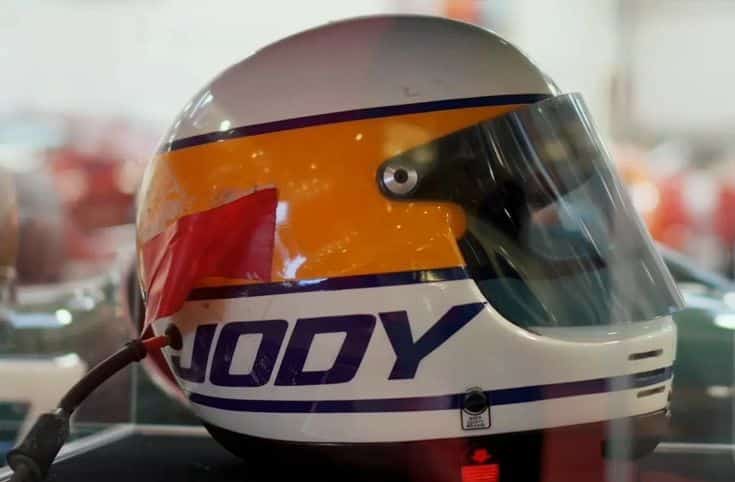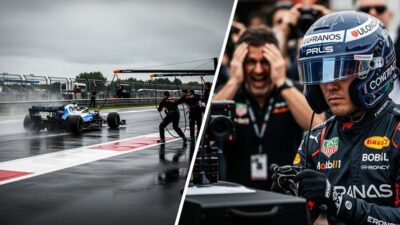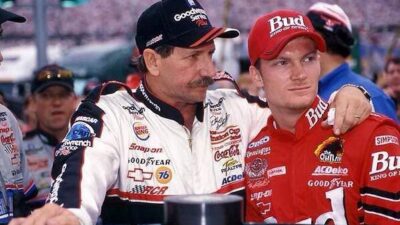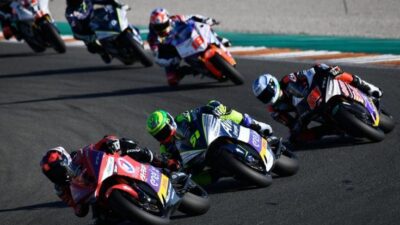Racing has always been a dangerous sport, with drivers facing extreme risks at high speeds. Racing helmet evolution tells the story of how simple leather caps transformed into today’s advanced safety equipment. Modern Formula 1 helmets are engineering marvels made from carbon fiber and Kevlar, weighing just 1.25 kilograms and consisting of about 17 layers of protection.

In the early days of motorsport, drivers wore basic leather caps with goggles that offered minimal protection from bugs and wind. These primitive designs provided almost no crash protection as racing speeds increased. The death rate among drivers reflected the lack of proper safety equipment during this era.
The transformation from cloth to modern materials represents decades of innovation driven by tragic accidents and advancing technology. Today’s helmets incorporate features like fire resistance, impact absorption, and even heads-up display technology that early racers could never have imagined.
Key Takeaways
- Racing helmets evolved from basic leather caps in the early 1900s to sophisticated multi-layered carbon fiber designs today
- Major safety breakthroughs included fiberglass construction in the 1950s, flame-resistant Nomex material in the 1960s, and full-face protection in the 1970s
- Modern helmets integrate advanced technologies like rotational impact protection, cooling systems, and real-time data displays for drivers
Technological Advancements and Materials
Racing helmet technology transformed through three major innovations: fiberglass construction replaced leather for superior impact protection, Nomex materials provided critical fire resistance, and dirt skirts with improved airflow systems enhanced both safety and driver comfort.
Adoption of Fiberglass and Composite Materials
The 1950s marked a turning point when manufacturers introduced fiberglass helmets to replace leather caps. This shift provided dramatically improved durability and impact resistance compared to earlier designs.
Fiberglass offered several key advantages over traditional materials:
- Structural integrity during high-speed impacts
- Lightweight construction that reduced driver fatigue
- Consistent protection across different crash scenarios
The material allowed helmet designers to create hard shells that could withstand the forces generated in racing accidents. Unlike leather or cloth helmets, fiberglass maintained its shape and protective qualities even after multiple impacts.
Modern racing helmets evolved further with composite materials. Today’s Formula 1 helmets combine carbon fiber and Kevlar in approximately 17 layers. These advanced composites weigh just 1.25 kilograms while providing maximum protection.
The transition from soft materials to hard composite shells represents one of the most significant safety improvements in racing history.
Impact of Nomex and Fire Resistance
DuPont’s introduction of Nomex in the 1960s revolutionized racing helmet safety by addressing fire hazards. This flame-resistant meta-aramid material became essential as racing speeds increased and explosion risks grew.
Nomex properties that made it ideal for racing helmets:
| Feature | Benefit |
|---|---|
| Flame resistance | Prevents ignition during fires |
| Heat stability | Maintains structure at high temperatures |
| Lightweight | Reduces neck strain on drivers |
| Chemical resistance | Withstands fuel and oil exposure |
The material formed the basis of fireproof racing helmets that could protect drivers during post-crash fires. Before Nomex, drivers faced severe burn injuries even when they survived initial impacts.
Fire-resistant helmets became standard equipment as racing organizations recognized the life-saving potential. The technology proved crucial during accidents involving fuel spills or electrical fires.
Development of Dirt Skirts and Enhanced Airflow
Dirt skirts emerged as specialized helmet features designed to prevent debris from entering the helmet while maintaining proper ventilation. These flexible extensions attach to the helmet’s base and create a seal around the driver’s neck area.
Key functions of dirt skirts:
- Block dust and small debris during races
- Maintain helmet airflow systems
- Reduce driver distraction from particles
- Improve overall comfort during long races
Enhanced airflow systems developed alongside dirt skirt technology. Modern helmets incorporate integrated cooling systems that regulate temperature without compromising safety features.
Ventilation improvements include strategically placed air vents that direct fresh air across the driver’s face. These systems prevent visor fogging and reduce heat buildup during intense racing conditions.
The combination of dirt skirts and advanced airflow represents practical innovation. These features address real-world racing conditions where visibility and comfort directly impact driver performance and safety.
Evolution of Helmet Designs
Racing helmet designs transformed dramatically as safety technology advanced and drivers demanded better protection. The shift from open-face designs to full-face coverage revolutionized driver safety, while innovations in visors and personalization created the modern racing helmet.
The Introduction of Full-Face Helmets
Full-face helmets emerged in the 1970s as a major safety breakthrough. These helmets protected drivers from debris and fire that open-face designs could not stop.
The full-face design covered the entire head and jaw area. This gave drivers much better protection during crashes and fires.
Bell Sports created the first mass-produced racing helmet with an open-face design and visor. The company later helped develop full-face models that became standard in racing.
Racing organizations made full-face helmets required equipment. This rule change saved many lives as crashes became more severe with faster speeds.
The helmets also included fire-resistant materials like Nomex. This protected drivers during fuel fires that were common in racing accidents.
Advancements in Visors and Tear-Off Strips
Modern racing helmets feature advanced visor systems that protect drivers’ vision. Clear visors became standard equipment on all racing helmets.
Key visor features include:
- Anti-fog coatings
- UV protection
- Impact-resistant materials
- Quick-release systems
Tear-off strips became essential safety equipment in the 1980s. These thin plastic layers stick to the helmet visor before races.
Drivers pull off dirty or damaged strips during races. This keeps their vision clear without stopping to clean the visor.
Each helmet can hold up to 10 tear-off strips. Racing teams prepare fresh strips for every practice and race session.
The strips protect the main visor from scratches and damage. This makes helmets last longer and stay safer throughout the racing season.
Customization and Personalization Trends
Racing helmet designs evolved from simple protective gear to iconic symbols that define drivers. Each helmet tells a story about the person wearing it.
Drivers started adding personal colors and patterns in the 1960s. These designs helped fans identify their favorite racers during televised events.
Common design elements include:
- National flag colors
- Family crests or symbols
- Sponsor logos
- Personal artwork
Modern helmets feature complex paint schemes that cost thousands of dollars. Professional artists create unique designs for each racing season.
Team colors and cultural influences play major roles in helmet design choices. Many drivers honor their heritage through special color combinations.
Digital printing technology allows for detailed graphics and photos. Some drivers change their helmet design for special races or championship events.
The personalization trend continues growing as helmets become mobile advertisements for sponsors and personal brands.
Safety Innovations in Motorsports
Modern racing safety systems focus on protecting drivers’ heads and necks during crashes. The development of restraint devices and support systems has dramatically reduced serious injuries in high-speed accidents.
Integration of Head and Neck Support Devices
Racing safety evolved beyond individual protective gear in the 1990s. Engineers began developing systems that worked together to protect multiple body parts during crashes.
Head and neck support devices became essential after researchers studied crash forces. High-speed impacts create extreme loads on drivers’ necks and spines.
Traditional helmets alone could not prevent these injuries. The head would snap forward violently during frontal crashes, causing basilar skull fractures.
Key integration features include:
- Carbon fiber construction for lightweight strength
- Tether systems connecting helmets to restraint devices
- Adjustable shoulder supports for different driver sizes
- Quick-release mechanisms for emergency extraction
These systems distribute crash forces across the chest and shoulders. This prevents the head from moving too far forward or backward during impact.
The HANS Device and Injury Prevention
The Head and Neck Support (HANS) device revolutionized driver safety in the late 1990s. Dr. Robert Hubbard developed it after his friend died from basilar skull fracture in 1981.
The device sits on a driver’s shoulders and connects to the helmet with tethers. During a crash, it limits head movement to safe ranges.
HANS device specifications:
- Weight: 1.5-2 pounds
- Materials: Carbon fiber and Kevlar
- Tether length: 17-22 inches typically
- Movement limitation: 3-4 inches forward
NASCAR made HANS devices mandatory in 2001. Formula 1 required them starting in 2003. Other racing series quickly followed these safety requirements.
Studies show HANS devices reduce basilar skull fracture risk by over 80%. They also decrease neck compression forces by 40% during frontal impacts.
The device allows normal head movement during racing. Drivers can look left and right without restriction while maintaining protection.
Helmet Restraint Systems
Modern helmet safety systems include multiple restraint components. These work with head and neck support devices to maximize protection.
Helmet tethers attach at specific anchor points on the shell. The attachment locations are engineered to distribute loads evenly across the helmet structure.
Restraint system components:
- Primary tethers: Connect helmet to HANS device
- Secondary straps: Backup safety connections
- Quick-disconnect fittings: Allow rapid helmet removal
- Load-distributing plates: Spread forces across helmet surface
Tether materials must be strong yet flexible. Most use high-strength synthetic fibers that resist stretching under load.
The restraint systems undergo rigorous testing. Manufacturers test them at forces exceeding typical crash loads to ensure reliability.
Advanced helmet technologies now include smart sensors. These monitor impact forces and can alert medical teams automatically when dangerous loads occur.
Regular inspection of restraint systems is required. Teams check tethers and connections before each race to ensure proper function.
The Role of Standards and Governance
The tragic death of Pete Snell in 1956 sparked the creation of formal helmet testing standards that transformed racing safety. Modern motorsports now rely on strict regulations from governing bodies to ensure driver protection across all racing disciplines.
Formation of the Snell Memorial Foundation
The establishment of the Snell Memorial Foundation in 1957 marked a turning point in helmet safety standards. Pete Snell’s fatal racing accident the previous year highlighted the urgent need for proper helmet testing and certification.
The foundation developed rigorous testing protocols that went far beyond basic impact resistance. These standards examined penetration resistance, retention system strength, and flame resistance under controlled laboratory conditions.
Key Snell Testing Standards:
- Impact Testing: Multiple impacts at different velocities and angles
- Penetration Resistance: Sharp object protection using standardized strikers
- Retention Testing: Chin strap and buckle strength under extreme forces
- Flammability: Fire resistance measurements for shell and liner materials
The Snell Memorial Foundation updates its standards every five years. Each revision incorporates new research findings and addresses emerging safety concerns from real-world racing incidents.
The SA2020 standard represents the most advanced safety technology currently available. It includes stricter impact testing requirements and enhanced visor safety protocols compared to previous versions.
Impact of Safety Regulations in Motorsports
Racing organizations worldwide have adopted mandatory helmet standards that directly influence driver safety outcomes. The FIA, NASCAR, and IndyCar each maintain specific helmet requirements for their respective series.
These regulations create uniform safety baselines across different racing disciplines. Drivers cannot compete without helmets meeting or exceeding the prescribed certification levels for their specific racing category.
Major Racing Series Requirements:
- Formula 1: FIA 8859-2015 standard mandatory
- NASCAR: SFI 31.1/2015 or Snell SA2015/SA2020
- IndyCar: Snell SA2015 or SA2020 required
- Sports Car Racing: Varies by sanctioning body
The evolution of safety standards in racing reflects continuous improvements in materials science and crash research. Each new standard generation addresses specific failure modes identified through accident analysis.
Helmet manufacturers must submit products for independent testing before certification. This process ensures consistent quality and performance across different brands and price points.
Penalties for non-compliance include race disqualification and suspension from competition. These enforcement mechanisms maintain the integrity of safety requirements throughout motorsports.
Modern Helmet Engineering and Formula 1
Today’s Formula 1 helmets represent the peak of protective technology, combining advanced materials like carbon fiber and Kevlar with sophisticated aerodynamic designs. These engineering marvels integrate complex communication systems and precise ventilation while maintaining strict weight limits.
Formula 1 Helmet Construction and Aerodynamics
Modern Formula 1 helmets are engineering masterpieces that blend cutting-edge materials with aerodynamic efficiency. The construction process involves layering multiple materials to create maximum protection while minimizing weight.
Each helmet consists of approximately 17 distinct layers that work together to absorb and distribute impact forces. The outer shell provides structural integrity while inner layers manage energy absorption during crashes.
Aerodynamic design plays a crucial role in modern F1 helmet engineering. Engineers shape the helmet surface to reduce drag and prevent air buffeting at high speeds. Special fairings integrate seamlessly with the car’s aerodynamics.
The visor opening has become much narrower in recent designs to improve structural strength. This change followed new FIA certification standards introduced in 2019 that enhanced overall helmet integrity.
Weight distribution remains critical for driver comfort and safety. Engineers carefully balance protective materials with ergonomic design to prevent neck strain during high-G cornering and braking forces.
Use of Carbon Fiber and Kevlar in Racing Helmets
Carbon fiber serves as the primary structural material in modern Formula 1 helmets, offering exceptional strength-to-weight ratios. This material provides superior impact resistance while keeping helmet weight to just 1.25 kilograms.
The carbon fiber weave pattern varies throughout different helmet sections. High-stress areas receive denser fiber placement while other zones use lighter configurations to optimize protection and comfort.
Kevlar integration adds puncture resistance and energy absorption capabilities. This material works alongside carbon fiber to create a composite structure that can withstand extreme impacts and temperatures.
Racing helmets must resist temperatures up to 790°C and stop projectiles traveling at 250 km/h. The carbon fiber-Kevlar combination achieves these demanding specifications without compromising weight limits.
Zylon material, twice as strong as Kevlar, gets woven directly into the helmet shell. This military-grade material replaced the separate Zylon strips that protected drivers after Felipe Massa’s 2009 accident at the Hungarian Grand Prix.
Communication and Ventilation Systems
Built-in communication systems allow constant contact between drivers and their pit crews during races. Microphones and speakers integrate seamlessly into the helmet padding without adding significant weight or bulk.
Ventilation channels throughout the helmet structure manage airflow and temperature control. Strategic placement of intake and exhaust ports creates positive air circulation that prevents visor fogging.
The ventilation system includes multiple air pathways that direct cool air across the driver’s face and scalp. These channels also help remove moisture and hot air generated during intense racing conditions.
Communication wiring routes through dedicated channels within the helmet structure. This design protects delicate electronic components while maintaining the helmet’s structural integrity and safety certifications.
Advanced padding systems work with ventilation channels to create comfortable fit while ensuring proper air circulation. The padding materials resist fire and manage moisture during long racing sessions.
Frequently Asked Questions
Racing helmet technology has transformed from basic leather caps to advanced carbon fiber systems with multiple safety layers. Modern helmets incorporate flame-resistant materials, impact protection systems, and sophisticated visor technologies that have dramatically improved driver survival rates.
What safety features have been added to racing helmets over the years?
Early racing helmets offered minimal protection with leather caps and goggles. The introduction of fiberglass in the 1950s provided the first real impact resistance for drivers.
Nomex flame-resistant material became a game-changer in the 1960s. This meta-aramid material formed the basis of fireproof racing helmets that protected drivers from fire during crashes.
Full-face helmets arrived in the 1970s, protecting drivers from debris and flames. These helmets included fire protective hoods and standard visors for enhanced eye protection.
The HANS device emerged as a critical safety addition. Formula One mandated HANS devices in 2003 after extensive testing to prevent head and neck injuries during high-speed impacts.
Modern helmets now include rotational impact protection systems. MIPS technology reduces brain injury risks from rotational forces during crashes.
How has F1 helmet technology evolved to improve driver protection?
Modern F1 helmets represent advanced engineering achievements. Current Formula 1 helmets weigh just 1.25 kilograms while providing maximum protection through lightweight design.
These helmets consist of approximately 17 layers of protection. Each layer serves a specific purpose in absorbing impact forces and protecting against fire.
Computer-aided design technology transformed helmet fitting in the 1980s. CAD allowed precise customization to individual driver head shapes, reducing fatigue during long races.
Aerodynamic improvements became standard in the 1990s. Sleeker helmet designs reduced air resistance while maintaining all safety features.
What are the testing standards for contemporary racing helmets?
Contemporary racing helmets must meet strict certification standards. Different racing series require specific safety certifications before helmets can be used in competition.
Impact testing simulates crash scenarios at various speeds and angles. Helmets undergo penetration tests to ensure debris cannot breach the shell during accidents.
Fire resistance testing validates flame-retardant properties. Helmets must withstand direct flame exposure for specified time periods without compromising structural integrity.
Regular recertification ensures helmets maintain safety standards. Most racing organizations require helmet replacement or recertification every few years.
How has the introduction of materials like carbon fiber changed helmet design?
Carbon fiber revolutionized helmet construction through superior strength-to-weight ratios. This material allows helmets to be lighter while providing better impact protection than previous materials.
Modern F1 helmets combine carbon fiber with Kevlar for optimal protection. This combination creates helmets that are both lightweight and incredibly strong.
Carbon fiber enables more complex helmet shapes. Designers can create aerodynamic profiles that were impossible with heavier materials like fiberglass.
The material allows for thinner shell construction. Carbon fiber helmets can be made thinner while maintaining strength, providing more interior space for padding.
In what ways have racing helmet visors advanced to enhance visibility and safety?
Early racing helmets used separate goggles for eye protection. The transition to integrated visors provided better sealing against debris and improved aerodynamics.
Anti-fog coatings prevent vision impairment during races. Multiple visor layers can include heating elements to maintain clear visibility in various weather conditions.
Tear-off visor strips allow drivers to maintain clear vision. Multiple transparent layers can be removed during races when dirt or oil obscures the view.
Optical clarity improvements reduce eye strain and fatigue. Modern visors use advanced materials that provide distortion-free vision across the entire field of view.
What are the most significant milestones in the history of racing helmet development?
The shift from leather caps to hard shells marked the first major advancement. Fiberglass helmets in the 1950s provided the first real impact protection for racing drivers.
Nomex introduction in the 1960s created the first flame-resistant helmets. This development directly addressed fire risks that claimed many driver lives in early racing.
Full-face helmet adoption in the 1970s eliminated most facial injuries. This design became the standard configuration still used today.
The HANS device integration represented the most recent major milestone. This system prevents the basilar skull fractures that killed several prominent drivers in the 1990s and early 2000s.









